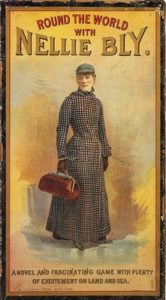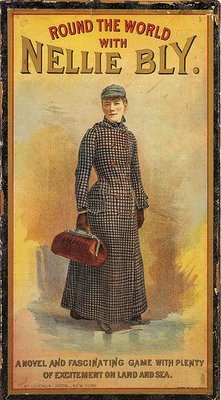72 days, 6 hours and 11 minutes established 25-year old New York World journalist Nellie Bly as the record holder for fastest trip around the world starting from Hoboken, New Jersey and finishing in Jersey City. The date she completed her around the world trip was January 25, 1890.
Her initial idea pitched to her editor Joseph Pulitzer in 1888 was based on besting the 80 days of Phileas Fogg, the fictional character of the novel Around the World in Eighty Days by Jules Verne, published in 1873. Phileas Fogg traveled London to London. Aside from Nellie Bly traveling by ship around India rather than by the newly built train tracks across India taken by Phileas Fogg, her actual route and his route from the novel are similar.
Nellie Bly met Jules Verne at his house in Amiens, France less than two weeks into her trip. She describes a scene where he has a world map in the hallway showing the route of Phileas Fogg and in her presence draws her proposed route on his map.
While we were examining the wealth of literature that was there before us, M. Verne got an idea. Taking up a candle and asking us to follow, he went out into the hall; stopping before a large map that hung there, holding up with one hand the candle, he pointed out to us several blue marks. Before his words were translated to me, I understood that on this map he had, with a blue pencil, traced out the course of his hero, Phileas Fogg, before he started him in fiction to travel around the world in eighty days. With a pencil he marked on the map, as we grouped about him, the places where my line of travel differed from that of Phileas Fogg.
Around the World in Seventy-Two Days, Nellie Bly
One of my favorite parts of her story is how she came up with the idea one weekend in a sleepless panic over having no writing ideas to present to her news editor for a story on Monday. In the middle of the night she thought of trying to beat the 80 days around the world of Phileas Fogg. Her excitement after studying steamship schedules and discovering it was potentially possible to travel around the world in less than 80 days is the kind of joy many of us experience as we realize the feasibility of time connections we can make to travel to different places we want to see on our own journeys in the time we have allotted to fulfill our missions of exploration.
Then I wondered if it were possible to do the trip [in] eighty days and afterwards I went easily off to sleep with the determination to know before I saw my bed again if Phileas Fogg’s record could be broken.
I went to a steamship company’s office that day and made a selection of time tables. Anxiously I sat down and went over them and if I had found the elixir of life I should not have felt better than I did when I conceived a hope that a tour of the world might be made in even less than eighty days.
Her hopes were quickly dashed by the newspaper when objections to her around the world proposal included the fact she was a woman would require her to be accompanied by a protector, she would require too much luggage and she spoke only English.
“It is impossible for you to do it,” was the terrible verdict. “In the first place you are a woman and would need a protector, and even if it were possible for you to travel alone you would need to carry so much baggage that it would detain you in making rapid changes. Besides you speak nothing but English, so there is no use talking about it; no one but a man can do this.”
“Very well,” I said angrily, “Start the man, and I’ll start the same day for some other newspaper and beat him.”
A year later she was notified with little more than 48 hours notice that her around the world project was approved if she could leave immediately. She had one custom-made dress fitted and finished in an afternoon and packed a single bag for a 75-day trip around the world.

By the time Nellie Bly returned to the United States, arriving in San Francisco less than ten weeks after her departure from New Jersey, she had become a major celebrity and a sensation as she traveled across the country.
I leaned over the platform and shook hands with both hands at every station, and when the train pulled out crowds would run after, grabbing for my hands as long as they could. My arms ached for almost a month afterwards, but I did not mind the ache if by such little acts I could give pleasure to my own people, whom I was so glad to be among once more.
She had traveled to England, France, Italy, Egypt, Japan, the United States, and the following British possessions: Aden, Arabia; Colombo, Isle of Ceylon; Penang, Prince of Wales Island; Singapore, Malay Peninsula; and the Island of Hong Kong.
Nellie Bly’s book Around the World in Seventy-Two Days is a fascinating read as a time capsule glimpse into late-19th century travel by train and ship, colonial attitudes in many parts of the world, racism, and sexism. Yet, many of her sentiments and descriptions of travel are similar to those travelers have today. With an even closer approximation to ‘lightning travel’ possible in our age of travel, we calculate by minutes time needed to travel to an airport, check-in for a flight, and arrive at an international destination 6,000 miles away. We have the ability to plan hour by hour our journeys around the world. And we contend with delays to our itinerary and disruptions to our plans.
Smithsonian Magazine – Nellie Bly’s Record-Breaking Trip Around the World Was, to Her Surprise, A Race
Nellie Bly – Around the World in Seventy-Two Days
American Experience – Nellie Bly ( 50 minutes documentary video 2005)




1 Comment
Comments are closed.